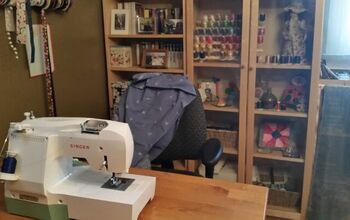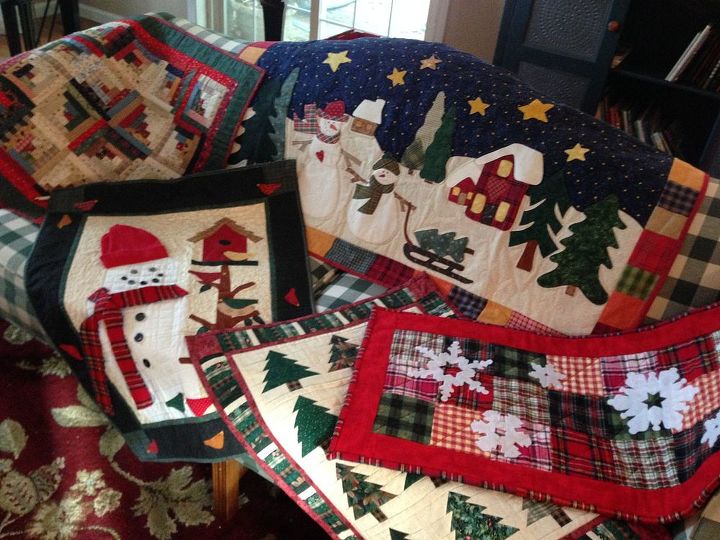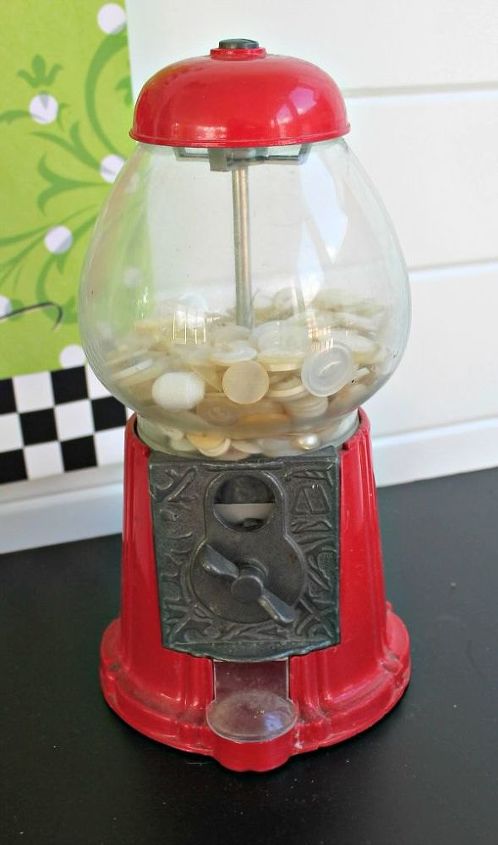Organize sewing room

-
The best way to utilize a small sewing room is to go up. Get shelving that goes up the wall, and use storage containers. Use organizers for ribbon, thread, etc, containers for scissors, like bright colored buckets, etc. There are tons of great ideas on Pinterest, you will definitely find something there, tons of ideas. I have white bookcases and shelving units, and I took the doors off the closet and moved in a dresser, so have the drawers full, plus the top shelf of the closet, plus the top of the dresser, and have some room on the side to store taller items. I then hung semi sheer, glittery, turquoise curtains, only one panel, with grommets, so I can easily close it off when I'm not using it, and add color. I have similar curtains at the window, and have several pink and turquoise pictures where there's wall space. I have two white sofa tables, with bottom shelves, so have more storage containers under, and on top of those. I try to buy storage containers that are clear with colorful lids, to bring color to a mostly white room. I also use this room to engrave on glass/wood/metal, so have a compressor under the table, and containers with blank pieces to carve. It sounds like a cluttered mess, and I guess it is, but it's an organized mess, a place for everything. I forget where I put things, so have a book that I write down what's in each container, and number them all, I do the same in my craft room, way too much stuff to remember. Anyway, that's kind of what I do, I have a semi small spare room, but I'd definitely look at Pinterest.
 Cindi
on Feb 07, 2016
Helpful Reply
Cindi
on Feb 07, 2016
Helpful Reply -
-
Cindi gives great resource- Pinterest- here is a pic of an area in my sewing/craft room where I built in some Ikea shelving units (these were free from someone throwing them out). I use plastic school boxes (which went on clearance for a dime a piece a couple years back) for my craft supplies. I will try to remember to post pictures of the rest of the my room. Everything has a place and a purpose- I use baskets and boxes to neatly put things away (not perfect but works). I put my thread inside the cabinet to keep dust off (my husband got it for me one year on ebay and it had the thread stand which works great) let me know if you would like to see more
 The Garden Frog with C Renee
on Feb 07, 2016
The Garden Frog with C Renee
on Feb 07, 2016
 Helpful Reply
Helpful Reply -
-
If there is a closet, create shelving that addresses your particular needs, use creative ideas in storing those small items. Use the walls for additional storage and create your sewing/cutting/ironing area in the center of the room. I'm in the process of designing my studio, whereby I'm using decorative photo storage boxes with label holder for those small items, and standard size file boxes with lids for fabric, yarn and needlework. I'm going to cover the storage boxes with colorful duck tape with a decorative number on them, so I can easily locate what I'm looking for, with the help of inventory software.
 LD
on Feb 07, 2016
Helpful Reply
LD
on Feb 07, 2016
Helpful Reply -
-
that's what I did in my room. The pegboard is from Home Depot.
 Inga H
on Feb 07, 2016
Inga H
on Feb 07, 2016








 1 marked as helpful Reply
1 marked as helpful Reply -
-
All good ideas. My sewing room is a bedroom. I have my cotton fabric by color in plastic bins on shelves I have sitting inside my closet. I have pegboard and will use that as Inga H suggested. I want to paint it and frame it. I have seen this done by others. I also have shelves next to my sewing machine that has plastic drawers holding thread, books, pins and needles, elastic, etc. It all depends on your individual sewing needs.
 Marge
on Feb 07, 2016
Helpful Reply
Marge
on Feb 07, 2016
Helpful Reply -
-
Cindi is right, go vertical. Think of your walls as horizontal space. As you can see from the pictures other ladies have posted, they have excellent use of their walls. I would add that to minimize expense, use containers from around the house to organize your stuff. You can buy flexible chalkboard labels like these http://smile.amazon.com/s/ref=nb_sb_noss?url=search-alias%3Daps&field-keywords=flexible+chalkboard+labels to affix to these containers to tell you at a glace what they contain.
 Liliana Wells
on Feb 07, 2016
Helpful Reply
Liliana Wells
on Feb 07, 2016
Helpful Reply -
-
Here are some areas of my sewing room
 The Garden Frog with C Renee
on Feb 07, 2016
The Garden Frog with C Renee
on Feb 07, 2016



 Helpful Reply
Helpful Reply -
-
When I decided to reorganize and rearrange my studio I used graph paper to draw the room, using each square to equal six inches. I did the floor space, and I did each wall on a separate sheet. On the walls' sheets I made sure to include doors, windows and especially electric outlets and light switches. Then I measured my furniture and made paper pieces to represent them, using graph paper, with each square representing six inches. That way I could move the "furniture" around to find the most efficient use of the space. My studio was a bedroom with such a small closet that it was basically useless and really messed up the use of the room. So, we tore the closet out! What a difference that made. We used the door from the closet to make a work table, and my hubby attached a smaller table to it for my sewing machine. The work table (sitting height) went into the corner and the sewing table connected to it, on the right edge by the wall. This allows me to sew and have a small ironing spot right next to me for doing quilt blocks. My cutting table is 36" high to make it easier to cut fabric. I do lots of things on that table, it's great for wrapping presents at Christmas. I have those plastic rolling drawer carts under the cutting table for storage, as well as cabinets and bookcases on the walls. It's surprising how much you can get into a room when you have multiple "tables" with space underneath to put your stash! I also have shelves on the walls above the tables.
 Jean DeSavage
on Feb 07, 2016
1 marked as helpful Reply
Jean DeSavage
on Feb 07, 2016
1 marked as helpful Reply -
Related Discussions
How to fold a fitted sheet?
Can someone tell me how to fold a fitted sheet so that it fits nicely in my linen closet?
IKEA sewing room
Has anyone put together a sewing room with IKEA components? I'm wondering what could be used as a sewing table- appropriate height and load-bearing capacity? Any othe... See more
How do I organize a 10x11 room as office/sewing/guest room?
How to arrange &organize home office in 8x10 room, 1 window. wide door
3Bookcases 7 ft tall take up 1 wall, Love to read daily.,,Retired primary teacher 27 yrs. What to do with all wonderful folktale books now out of print? Papers by t... See more
Bedroom/sewing room
Hometalkers...posts some pics of of your bedroom slash sewing room. I am at a loss as to how to incorporate the two :-) I will post my bedroom later.
What to do with a vintage gum ball machine
I had this red gum ball machine in my storage building and decided to pull it out and use it for something. What am I filling it with? BUTTONS - All white of course!


